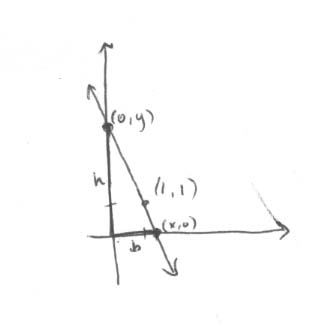Science:Math Exam Resources/Courses/MATH110/April 2011/Question 07 (c)/Solution 1
The question is asking us to minimize the area of a triangle. So the function that we will be minimizing is
where b is the triangle's base and h is its height. In order to optimize (in this case, minimize), we need to reduce this formula to a function of one variable.
If we draw a picture of a line with negative slope that passes through (1,1), we will see the triangle formed by the axes and the line and can label its base and height.
So the base of the triangle is equal to the distance between 0 and the x-intercept of the line (which is simply the value of the x-intercept) and similarly, the height is equal to the y-intercept. We calculated the x and y intercept in the previous part of the question, so now we can simply plug them into our area formula for b and h.
We now take the derivative of A...
...and find its critical points. The derivative is undefined when . Setting it equal to zero:
yields additional critical points of and . However, as stated in the question, , so the only valid critical point is . To check that this is a minimum, you could use the first or second derivative test.










